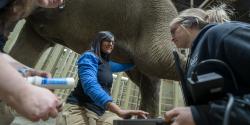Like other tigers, the coat of Amur tigers is golden-orange with dark stripes. Each animal has stripes that are unique, like fingerprints.
Amur tigers have more white and fewer stripes than other tigers. These colors help them hide in their environment: white is like snow, black like shadows and yellow like dead oak leaves.
Scientific Name: Panthera tigris altaica
Conservation Status: Endangered
Size: Males can measure up to 10 feet in length from nose to tail, and females may be up to 8.5 feet.
Weight: Males can weigh more than 600 pounds; females can weigh more than 300 pounds.
Median Life Expectancy: Female: 14.3 years; Male: 16 years










